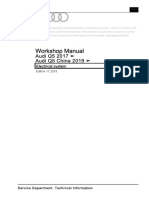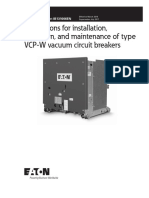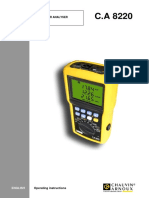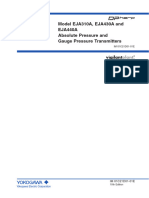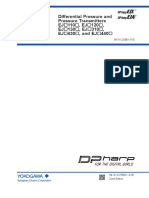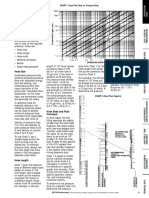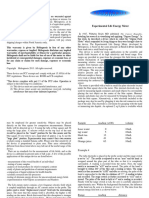Wta4410us SM
Wta4410us SM
Uploaded by
dratrats07Copyright:
Available Formats
Wta4410us SM
Wta4410us SM
Uploaded by
dratrats07Original Title
Copyright
Available Formats
Share this document
Did you find this document useful?
Is this content inappropriate?
Copyright:
Available Formats
Wta4410us SM
Wta4410us SM
Uploaded by
dratrats07Copyright:
Available Formats
R
REEPPA
AIIR
R IIN
NSSTTR
RUUC
CTTIIO
ONN
Repair instractions
1 SAFETY ........................................................ 2 6.7 Motor.................................................................................. 18
6.8 Belt removal KI01.............................................................. 19
1.1 SAFETY................................................................................ 2
6.9 Belt Tension adjuster ....................................................... 19
1.3 EEC ...................................................................................... 3
6.10 Removing the Ki03 belt .................................................... 20
2 INSTALLATION ............................................ 5 6.11 Heating element ................................................................ 22
2.1 Set-up / Installation............................................................. 5 6.12 Disassembly safety temperature regulator KI01............ 23
3 OPERATION ................................................. 6 6.13 Removal of safety temperature regulator KI02 .............. 24
6.14 Removing temperature regulator exhaust air ................ 25
3.1 Control Panel....................................................................... 6
6.15 Drum bearings .................................................................. 26
3.2 Disassembly ........................................................................ 7
6.16 Diagnostic-repair tools..................................................... 27
3.3 Optimisation buttons optional ........................................... 8
7 FAULT DIAGNOSTICS ...............................28
4 COMPONENTS............................................. 9
7.1 Time jumps........................................................................ 28
4.1 Power module (optional) .................................................... 9
7.2 Odour................................................................................. 29
4.2 Program – Residual moisture ............................................ 9
7.3 Leaks ................................................................................. 29
5 FUNCTIONS ............................................... 10 8 TECHNICAL SPECIFICATIONS.................30
5.1 Removal of safety temperature regulator KI01............... 10
5.2 Removal of safety temperature regulator from KI02..... 11
6 REPAIR....................................................... 12
6.1 Facia Panel ........................................................................ 12
6.2 Door ................................................................................... 13
6.3 Interior and outer door ..................................................... 13
6.4 Front Panel ........................................................................ 14
6.5 Bearing plate ..................................................................... 16
6.6 Removal of Drum interior lighting (Optional) ................. 17
113_58300000104082_ara_en_h.doc – 19.03.07 Seite 1 von 30
1 SAFETY
1.1 SAFETY
WARNING!
DANGER!
Observe the following advice at all times:
When carrying out a measurement according to VDE 0701 using the
connecting plug, the safety test must be carried out as described in
Repairs may only be carried out by an electrical specialist!
the circuit diagrams.
Inappropriate repairs may cause danger to the user or cause damage
for the user!
To avoid the danger of electric shock, observe the following advice at
Component may carry an electrostatic charge! Follow
all times:
the handling regulations
Housing and frame may be live as a result of a fault!
Dangerous body currents may flow as a result of touching live
components within the appliance!
Disconnect the appliance from the mains before repair!
An earth leakage circuit breaker must always be used when testing
while voltage applies!
The protective conductor resistance may on no account exceed the
value given in the standard! It is crucial with respect to both personal
safety and appliance function.
Following repair, tests must be carried out according to VDE 0701 or
according to regulations specific to the country concerned!
Following repair, both function tests and leak tests must be carried
out.
113_58300000104082_ara_en_h.doc – 19.03.07 Seite 2 von 30
1.3 EEC ► of up to 35,000 V, if you walk over a non conductive carpet,
1.1.1 Description ► of up to 12,000 V, if you walk over a non conductive PVC soil
► and of up to 1,800 V, if you sit on a padding chair.
Electrostatically -
The electrostatic voltage of their body is passed to electronics and
EEC`s affected by them, which are possibly damaged thereby.
Endangering -
Components
1.1.2 Generally
Dead
Economy, environmental protection, control comfort, high functionality ► A defect part
and working reliability are realized with electrical household
appliances by the insertion of most modern electronics. This high- ► A defect component
quality technology requires a professional handling and a competent ► A defect appliance
specialized knowledge.
All electronic modules are equipped with components, which are
endangered by an electrostatic voltage.
1.1.3 Endangered coponents Slightly hurt
The following elements are endangered by electrostatic voltage: ► Damaged
► Weakened
► µ Processors and IC`s
► Transistors, thyristors and Triac`s ► Early failure
► Diodes
1.1.4 Causes and effect
They lead an electrostatic voltage with itself:
113_58300000104082_ara_en_h.doc – 19.03.07 Seite 3 von 30
1.1.5 EEC – Notes
On all electronics modules and electronics components are
electrostatically endangered elements
.
For the protection of these electrostatically endangered elements the
following measures are to be met:
Noticing the appropriate marking of the components and modules:
Put on before contact and measurement of the EEC`s a electrostatics
protective system (bracelet with grounding component).
Avoid the contact of EEC`s with rechargeable plastics (foils etc.).
Components, modules and PC-boards are to be touched in such a
way that the conductive strips or connections are if possible not
affected.
EEC`s may arrive not too close at monitors and televisions.
Use for transport only conductive materials or the original packaging.
1.1.6 Electrostatics protective system
The electrostatic voltage of the body is derived over the bracelet and
the grounding component.
This takes place for safety reasons not directly, but over a resistance
combination.
The ground connection and/or protective grounding binding must be
perfect!
113_58300000104082_ara_en_h.doc – 19.03.07 Seite 4 von 30
2 INSTALLATION
2.1 Set-up / Installation
The appliance must be located firmly and at floor level. Use a water-
level.
A Exhaust air hose max. 2 B Power supply cable 1.5m
m
► The dryer can neither be built in nor set up under an ► The feet are adjustable for height.
appliance. ► Loosen the counter nuts. Adjust the feet so that the appliance
► The dryer can be set up in combination with a washing is at floor level. Then tighten the counter nuts.
machine (front loader). To ensure a reliable connection you ► The set-up place should be chosen in a way that the minimum
have to use the original connection kits (see operation distance of 10 cm to the wall can be kept.
instruction).
113_58300000104082_ara_en_h.doc – 19.03.07 Seite 5 von 30
3 OPERATION
3.1 Control Panel
A Programme selector B Programm progress indicator
C LED - Modul (Optional) D Additional funcations
E Start button
113_58300000104082_ara_en_h.doc – 19.03.07 Seite 6 von 30
3.2 Disassembly
► Worktop Disassembly.
► 3 screws on the panel disassembly (B).
► Panel forward overboard end to upturn.
A Screws button and Modul
B Screws panel
113_58300000104082_ara_en_h.doc – 19.03.07 Seite 7 von 30
3.3 Optimisation buttons optional
Low heat button:
For temperature-sensitive textiles.
Lowers the temperature by reducing the heat output, the drying time is
extended simultaneously.
Signal:
For switching on the signal and drawing attention to the end of the
programme.
Start:
When a programme starts, a brief acoustic signal sounds when the
signal is switched on.
Start time delay:
The start time of the programme can be delayed up to 19 hours. A dot
flashes on the display. The selected time elapses in 1 h steps.
Programme progress indicator (status)
The programme sequence is indicated by LEDs.
Anti-crease
At the end of the 10`of colldown the program starts its anti-crease
phase. It can be interrupted by the user anytime. The Anti-crease is
limited on 60 min
113_58300000104082_ara_en_h.doc – 19.03.07 Seite 8 von 30
4 COMPONENTS 4.2 Program – Residual moisture
4.1 Power module (optional) The programs "Easy care" and "Cotton / Color laundy" damp-steered
and after reaching the drying goal or the maximum running time (180
min) were terminated. A cooling phase of 10 min follows. At the end of
Description of function
the cool down phase a signal of 5x1sec.sounds.
The module contains all components, like regulation, microprocessor
and relay. It takes over functions of the control of expirations of drying,
determination of parameters as well as the control of motor and Residual moisture:
heating.
Cotton- / Color laundry
Extra dry -4%
Conductance measurement Wardrobe dry plus -2%
The drying goal is determined by a conductance measurement. The Wardrobe dry 0%
conductance measurement is attributed to a resistance test. Easy dry 6%
Ironing dry 12%
Easy care
Very dry 0%
Wardrobe dry 2%
Easy dry 6%
Ironing dry 12%
Anti crease protection
The time for the “Anti crease protection” is limited on 60 min. An
prolongation time is not possible.
113_58300000104082_ara_en_h.doc – 19.03.07 Seite 9 von 30
5 FUNCTIONS
5.1 Removal of safety temperature regulator KI01
At the bottom channel cover the safety temperature regulator is
installed. The safety temperature regulator switches
switching off temperature: 120 °C +/- 3K
Safety temperatur by ca. 150 °C +/- 4K
A Temperature regulator processing air
B Safety temperature regulator
Hinweis
The safety disconnection may not be put back. The conversion kit
447311 must be inserted. See disassembly safety temperature
regulator KI01
113_58300000104082_ara_en_h.doc – 19.03.07 Seite 10 von 30
5.2 Removal of safety temperature regulator
from KI02
At the bottom channel cover the safety temperature regulator is
installed. The safety temperature regulator switches
switching off temperature: 120 °C +/- 3K
Safety temperatur by ca. 150 °C +/- 4K
Hinweis
B Safety temperature regulator 150°C
After elimination of errors the safety temperature regulator can be put C Temperatur regulator100°C
back.
D Current linkage
113_58300000104082_ara_en_h.doc – 19.03.07 Seite 11 von 30
6 REPAIR
6.1 Facia Panel
6.1.1 Dismantle facia panel
► Dismantle work top plate
► Above the facia panel remove 5 screws (B)
► Release facia panel forward and then turn upward.
► Take off the data line from electronics at the facia panel.
► Remove selector switch, switch holder and operating lamp.(A)
A Screws at the electronic
B Screws facia panel
A Screws selector switch holder
113_58300000104082_ara_en_h.doc – 19.03.07 Seite 12 von 30
6.2 Door 6.3 Interior and outer door
The outer door and internal door are only with one another clipped Removal of the Interior and outer door
► The outside -und internal door are only with one another rest.
Removal of the Door ► At the hinge opening with a slotted bolt turner set and outer
door of the internal door release.
► Take off the two crews at the door with a Phillips screwdriver
to loosen and dismantle the door.
► Remove the hinge support.
outer door internal door
Mounting
Outside -und internal door it rests in such a way that the inside and
► With a slot screwdriver release at the hinges opening the outer door sit again parallel.
respective side.
113_58300000104082_ara_en_h.doc – 19.03.07 Seite 13 von 30
6.4 Front Panel 1 walked
Dismantling Front Panel
► Remove work top panel.
► Dismantle Facia Panel
► Door removal.
► Take off all screws (A/B/C und D)
► Electronics and wiring harness solve and take away front
panel.
A 2 Screws PC-Board
B Screws facia panel and front panel
C 7 Screws bearing panel
D 3 Screws bottom panel
113_58300000104082_ara_en_h.doc – 19.03.07 Seite 14 von 30
► Electrical connections from the drum interior lighting and door
switch take off. 3 walked
2 walked
A Plugs drum lighting and door switch
► Develop after front front of.
► Cable straps loosen and wiring harness with key bank
dismantle.
113_58300000104082_ara_en_h.doc – 19.03.07 Seite 15 von 30
6.5 Bearing plate
Picture 2
Disassembly bearing plate
► Remove work top plate and facia panel.
► Remove front panel.
► Disconnect the electrical connection to the drum interior
lighting.
► Take away the door switch.
► Screws (A) dismantle. Bearing plate on the left and on the
right release and develop forward.
► Temperature regulators and exhaust air duct dismantle.
Picture 1
A Bearing plate B Latch hook bearing plate
113_58300000104082_ara_en_h.doc – 19.03.07 Seite 16 von 30
6.6 Removal of Drum interior lighting (Optional)
► Remove the top work panel
► Remove the facia panel.
► Take of the plug of the lamp.
► Remove the lamp cover.
► Release the retaining tie-clip with a slot screwdriver.
A Support clip B Lamp socket
A Electrical connections
113_58300000104082_ara_en_h.doc – 19.03.07 Seite 17 von 30
6.7 Motor Pic 1
The Drying Phase:
Motor rhythm: 118s right 3s off 118s left.
The Cool down Phase:
When the required humidity threshold or the time of the sequence are
reached, the program starts its cool down phase. It lasts 10min.
Motor rhythm: 3s Off 118s right 3s Off 118s left.
Pic 2
Motor removal
► Take off back panel.
► Take away lower half of the heater channel.
► Put the appliance on the side put to open the base plate.
► Fix the motor shaft with 10 mm ring spanner.
► With a 13 mm ring spanner take off the exhaust wheel
► Release the belt through the opening in the base plate.
Take away the four screws of the motor at the base plate and Pic 3
Take the motor out through the opening in the base plate.
113_58300000104082_ara_en_h.doc – 19.03.07 Seite 18 von 30
6.8 Belt removal KI01 6.9 Belt Tension adjuster
► Take of the opening cover on the base plate. ► Put the appliance on the backside.
► Remove the belt from the belt tension adjuster. ► Open the opening ion the base plate.
► Take off work top panel, facia panel, front panel and bearing. ► Take off the belt.
(see dismantling bearing plate.) Remove the two screws of the belt tension adjuster at the base plate
and take off belt tension adjusters over the opening in the base plate.
6.8.1 Belt mounting
► Draw up the belt over the drum
► Hang up and bolt bearing plate
► Stretch the belt with the belt tension adjuster
► Close the opening on the base
► Montage of the front panel, facia panel and work top panel.
113_58300000104082_ara_en_h.doc – 19.03.07 Seite 19 von 30
6.10 Removing the Ki03 belt Step 3
Protective gloves must be worn
1. Remove the worktop.
2. Remove the rear panel.
3. Pull off the electrical connections F for the heater and
temperature controller.
4. Remove the bottom process air duct cover.
5. Remove the process air impeller.
6. Detach the belt over the drum.
7. Remove the two top screws A on the process air duct.
8. Thread the belt between the process air duct and housing.
9. Insert and tighten the two screws A you removed earlier.
10. Remove the two bottom screws B on the process air duct.
11. Press the duct back and thread the belt between the housing
and process air duct (see step 8).
12. Remove the belt.
Stretch belt before assembly!
113_58300000104082_ara_en_h.doc – 19.03.07 Seite 20 von 30
Step 4 Step 7
Step 8
Step 5
B belt C cross bar
113_58300000104082_ara_en_h.doc – 19.03.07 Seite 21 von 30
6.11 Heating element
Removal
► Take off the back panel.
► Take away the bottom air duct cover.
► Disconnect the electrical connections.
► Take off the upper and bottom screws of the heating element.
113_58300000104082_ara_en_h.doc – 19.03.07 Seite 22 von 30
6.12 Disassembly safety temperature regulator KI01 Step.5
1. Equipment from electricity mains separate
2. Cover in the back dismantle
3. Electrical connections (F) take off
4. Processing air temperature regulator remains existing (G)
5. Lower processing air cover dismantle and by the conversion
kit 445193 replaced.
6. New processing air cover insert. Exhaust air and safety
temperature regulator again attach.
Step. 3
Step. 6
B Safety temperature regulator C Processing air
temperature regulator
F Electrical connections
113_58300000104082_ara_en_h.doc – 19.03.07 Seite 23 von 30
6.13 Removal of safety temperature regulator KI02
At the bottom channel cover the safety temperature regulator is
installed. The safety temperature regulator switches
switching off temperature: 120 °C +/- 3K
Safety temperatur by ca. 150 °C +/- 4K
B Safety temperature regulator 150°C
C Temperatur regulator100°C
D Current linkage
113_58300000104082_ara_en_h.doc – 19.03.07 Seite 24 von 30
6.14 Removing temperature regulator exhaust air
► Remove work top plate, facia panel, front panel and bearing
plate.
► Unscrew the two screws and remove the temperature
regulator.
A Temperature regulator exhaust air
113_58300000104082_ara_en_h.doc – 19.03.07 Seite 25 von 30
6.15 Drum bearings
Removal:
► Take off the back Panel.
► Remove work top panel, door, facia panel, front panel and
bearing plate.
► Bearing plate at the air duct loosen and drum forward remove
► Take out grounding pin and feather/spring.
► Remove snap ring and pull off the bearing plate mounting of
the drum axle pull
► Take out the defect bearings if necessary with a hammer.
113_58300000104082_ara_en_h.doc – 19.03.07 Seite 26 von 30
6.16 Diagnostic-repair tools Measuring lead connection
Measuring (50 cm) Mat.-Nr.:340954
Universally valid
Before each repair and/or examination of the equipment the KD test
program is to be started.
Probe tip
Probe tip material - No.: 340730 (with resistance tests absolutely the
construction units on the module take off).
Probe Tipp Optional
Probe Tipp Mat.-Nr.:340951 for SAFETY off KI02 for Relay plate
heating
Protective glove
Material Nr.: minimum 9 = 340728
Maximum size 10 = 340729
113_58300000104082_ara_en_h.doc – 19.03.07 Seite 27 von 30
7 FAULT DIAGNOSTICS
7.1 Time jumps
Customer complaint Cause Remedial action
Remaining running time jumps at the end of the Load too high, max.+100% Observe max. load.
programme
Time jumps Very high ambient temperature > 30 °C Ensure that there is adequate ventilation.
Initial moisture too high Increase spin speed.
Different types of washing. Varying residual Refer customer to different types of washing
moisture in the textiles. (cotton, synthetic fibres).
113_58300000104082_ara_en_h.doc – 19.03.07 Seite 28 von 30
7.2 Odour
Customer complaint Cause Remedial action
Scorching odour Drum overloaded Observe max. load.
Washing not suitable for drying Observe care symbols.
Foreign objects in the appliance Remove foreign objects.
Plug-in contacts / components Scorched plugs / replace components.
Chemical odour Detergent / fabric softener / scented cloths Changing detergent / fabric softener / scented
cloths, if possible do without fabric softener /
scented cloths.
7.3 Leaks
Customer complaint Cause Remedial action
Door leaking Seal dirty Clean door seal.
Seal damaged Replace door seal.
Exhaust air hose leaking Condensation in the exhaust air hose Check length of exhaust air hose.
See Pressure losses.
113_58300000104082_ara_en_h.doc – 19.03.07 Seite 29 von 30
8 TECHNICAL SPECIFICATIONS
113_58300000104082_ara_en_h.doc – 19.03.07 Seite 30 von 30
You might also like
- Gaggenau Eb904 Eb905 Eb944 Eb945 Eb964 Eb965 Eb984 Eb985-111 - 211 - 611 02 Oven Eb984611Document37 pagesGaggenau Eb904 Eb905 Eb944 Eb945 Eb964 Eb965 Eb984 Eb985-111 - 211 - 611 02 Oven Eb984611João Francisco Rivera FerrariNo ratings yet
- Micro Wave Oven Repair Guide PDFDocument45 pagesMicro Wave Oven Repair Guide PDFhareeshgs33% (3)
- Led TV Service ManualDocument58 pagesLed TV Service ManualmounirNo ratings yet
- Villa Endograph DC (Service Manual)Document106 pagesVilla Endograph DC (Service Manual)ALEXANDER JEAN BEDIA CONDORINo ratings yet
- Installation and Operating Instruction: Remote Control Station WCM-FS 2.0 and Solar Controller WCM-SOL 1.0 HomeDocument80 pagesInstallation and Operating Instruction: Remote Control Station WCM-FS 2.0 and Solar Controller WCM-SOL 1.0 HomeAnd B100% (2)
- Abs BendixDocument72 pagesAbs BendixVeterano del CaminoNo ratings yet
- Steelco Vs MC: Medium Capacity Steam SterilizerDocument43 pagesSteelco Vs MC: Medium Capacity Steam SterilizerGuillermo Jesus Avila Arrieta100% (1)
- Bosch Serie-6 Waq283s1gb 209 58300000178575 Ara Washing MachineDocument70 pagesBosch Serie-6 Waq283s1gb 209 58300000178575 Ara Washing MachineinternetovsNo ratings yet
- Neff s5456x Repair-ManualDocument51 pagesNeff s5456x Repair-ManualMilos JovanovicNo ratings yet
- 43 Uf 640Document126 pages43 Uf 640reginaldo020471No ratings yet
- Siemens Mosogatogep Hasznalati Utmutato Angolul SE66A592EUDocument54 pagesSiemens Mosogatogep Hasznalati Utmutato Angolul SE66A592EUAttila EngiNo ratings yet
- 5 15kv 27kv VCP W Instruction Booklet Ib131006enDocument78 pages5 15kv 27kv VCP W Instruction Booklet Ib131006enTomy ArgoteNo ratings yet
- Electrical SystemDocument284 pagesElectrical SystemРоман ТолочийNo ratings yet
- ICK68X ServiceDocument65 pagesICK68X ServiceBuitinės Technikos RemontasNo ratings yet
- User Manual 662903Document80 pagesUser Manual 662903Andres Requena SanchezNo ratings yet
- DISJUNTOR A VACUO - VCP-W, VCPW-SE, VCP-WC, and VCPWNDDocument72 pagesDISJUNTOR A VACUO - VCP-W, VCPW-SE, VCP-WC, and VCPWNDDavid Vichi de BritoNo ratings yet
- Manual Controlador GasesDocument52 pagesManual Controlador GasesstongbNo ratings yet
- Electrical System PDFDocument460 pagesElectrical System PDFRADEKNo ratings yet
- 5596 Operacion Ingles PDFDocument127 pages5596 Operacion Ingles PDFNodomed Info100% (1)
- Cummins GGPA GGPB GGPC Installation ManualDocument106 pagesCummins GGPA GGPB GGPC Installation ManualRajan Lakshmanan100% (2)
- VW Up 2017 Electrical System EngDocument165 pagesVW Up 2017 Electrical System Engjohoba5344No ratings yet
- SM 55.c PDFDocument339 pagesSM 55.c PDFjorge Angel Lope100% (1)
- CHINESPORTDocument36 pagesCHINESPORTbekmansur2016No ratings yet
- Pumps-Positive Displacement-Rotary-Waukesha Universal Service ManualDocument81 pagesPumps-Positive Displacement-Rotary-Waukesha Universal Service ManualИбрагим НурмамедовNo ratings yet
- Valve Control Tops Easymind 2 0 f783 Suedmo Operating Manual enDocument39 pagesValve Control Tops Easymind 2 0 f783 Suedmo Operating Manual enJosueGonzalezDePalaciosNo ratings yet
- Im01c20d01-01en (9) - Ej310, Ej430, Ej440Document79 pagesIm01c20d01-01en (9) - Ej310, Ej430, Ej440Nguyen ThuongNo ratings yet
- Sma Tripower 8000tl 10000tl 12000tl 15000tl 17000tl Installation GuideDocument128 pagesSma Tripower 8000tl 10000tl 12000tl 15000tl 17000tl Installation GuideKirsten HernandezNo ratings yet
- Cambi e Nap YokogawaDocument73 pagesCambi e Nap YokogawaKhánh LêNo ratings yet
- Electrical SystemDocument445 pagesElectrical SystemPeterNo ratings yet
- Chauvin Arnoux 8220Document43 pagesChauvin Arnoux 8220Danilo MuñozNo ratings yet
- User's Manual: Model EJA310A, EJA430A and EJA440A Absolute Pressure and Gauge Pressure TransmittersDocument83 pagesUser's Manual: Model EJA310A, EJA430A and EJA440A Absolute Pressure and Gauge Pressure TransmittersMarion TelliezNo ratings yet
- MCH 13 16 ManualDocument120 pagesMCH 13 16 ManualsmelloigorNo ratings yet
- SM 25Document404 pagesSM 25Daniel Cristian DideleaNo ratings yet
- Dpharp Vigilantplant Eja310aDocument76 pagesDpharp Vigilantplant Eja310aOscarNo ratings yet
- Im01c20b01-01en (9) - Ej110, Ej120, Ej130Document92 pagesIm01c20b01-01en (9) - Ej110, Ej120, Ej130Nguyen ThuongNo ratings yet
- User's Manual: Model EJA510A and EJA530A Absolute Pressure and Gauge Pressure Transmitters (Style: S2)Document70 pagesUser's Manual: Model EJA510A and EJA530A Absolute Pressure and Gauge Pressure Transmitters (Style: S2)Himanshu ShuklaNo ratings yet
- Coltri SubDocument92 pagesColtri SubZoran PetrovNo ratings yet
- Manual Ds416Document93 pagesManual Ds416JOAONo ratings yet
- 0463 658 201 GBDocument46 pages0463 658 201 GBcsak.adownhillNo ratings yet
- Combustion Oxygen Monitor: Endura AZ30 Series Probe and TransmitterDocument48 pagesCombustion Oxygen Monitor: Endura AZ30 Series Probe and TransmitterCarlos Andrés Vargas OsornoNo ratings yet
- SANDVIK CJ411:01: Operator's ManualDocument80 pagesSANDVIK CJ411:01: Operator's ManualECU Mod100% (2)
- Eaton Xgis Operation Maintenance Ib022017enDocument52 pagesEaton Xgis Operation Maintenance Ib022017enMatias Soto BilbaoNo ratings yet
- O&M - Control Valve - de NoraDocument60 pagesO&M - Control Valve - de NoraNaqib FuadNo ratings yet
- Liebert Gxt3 RT 5a10kva User ManualDocument44 pagesLiebert Gxt3 RT 5a10kva User ManualEdgar Alayo RojasNo ratings yet
- Manuel SoloDocument45 pagesManuel SoloRenua BondNo ratings yet
- Kohler 8.5-12RES InstallDocument44 pagesKohler 8.5-12RES InstallprosysscribdNo ratings yet
- Leeson Manual Speed Master ScrthyristorDocument60 pagesLeeson Manual Speed Master ScrthyristorJay ChimchomeNo ratings yet
- User's Manual: Differential Pressure and Pressure Transmitters EJ 110, EJ 120, EJ 130, EJ 310, EJ 430, and EJ 440Document65 pagesUser's Manual: Differential Pressure and Pressure Transmitters EJ 110, EJ 120, EJ 130, EJ 310, EJ 430, and EJ 440fragercitoNo ratings yet
- Installation: Residential/Commercial Generator SetsDocument44 pagesInstallation: Residential/Commercial Generator SetsEmilio CooperNo ratings yet
- Racks Ventilados Tecniplast BlueLineDocument81 pagesRacks Ventilados Tecniplast BlueLinepablo elviraNo ratings yet
- Condensing Units: Installation and Operations ManualDocument40 pagesCondensing Units: Installation and Operations ManualHoàngViệtAnhNo ratings yet
- HzmriomDocument55 pagesHzmriomahmedNo ratings yet
- Robustfeed Pro: Instruction ManualDocument46 pagesRobustfeed Pro: Instruction Manualkismikloshun55No ratings yet
- Im01c22d01-01en (17) - Eja310, Eja430Document83 pagesIm01c22d01-01en (17) - Eja310, Eja430Nguyen ThuongNo ratings yet
- TOA-S616-6.5B VS-616 G3 LN Instructions PDFDocument46 pagesTOA-S616-6.5B VS-616 G3 LN Instructions PDFPop-Coman SimionNo ratings yet
- Making Everyday Electronics Work: A Do-It-Yourself Guide: A Do-It-Yourself GuideFrom EverandMaking Everyday Electronics Work: A Do-It-Yourself Guide: A Do-It-Yourself GuideRating: 4 out of 5 stars4/5 (2)
- Artificial Island Construction Using Large Steel CylindersDocument11 pagesArtificial Island Construction Using Large Steel Cylindersross nagotNo ratings yet
- BDSLT Load TestDocument24 pagesBDSLT Load TestsiranepNo ratings yet
- Balancing Chemical EquationsDocument20 pagesBalancing Chemical EquationsShekinah Christoe100% (1)
- SSK Theories-of-FailureDocument18 pagesSSK Theories-of-FailureNikhil JadhavNo ratings yet
- 1537326530linear & Angular MeasurementDocument49 pages1537326530linear & Angular MeasurementAl MamunNo ratings yet
- MP-Series Small Frame Brushless Servo Motor: Installation InstructionsDocument20 pagesMP-Series Small Frame Brushless Servo Motor: Installation InstructionsODONELNo ratings yet
- Anchorage Zone DesignDocument40 pagesAnchorage Zone DesignNOBLE STAINES JNo ratings yet
- Plant Physiology Lab TechniquesDocument17 pagesPlant Physiology Lab TechniquesRaheel AhmadNo ratings yet
- UNIT 2 Electrons in Atoms - 2.1 Atomic Orbitals and Electronic ConfigurationDocument41 pagesUNIT 2 Electrons in Atoms - 2.1 Atomic Orbitals and Electronic ConfigurationSahana Kumar100% (1)
- Mayer Expansions Hamilton Jacobi - Brydges KennedyDocument31 pagesMayer Expansions Hamilton Jacobi - Brydges KennedyRene SNo ratings yet
- Operator'S Manual: 10 In. Table SawDocument132 pagesOperator'S Manual: 10 In. Table SawNana Obiri Yeboa DarkoNo ratings yet
- p1, p2 c1. General PhysicsDocument40 pagesp1, p2 c1. General PhysicsJamal RidzuanNo ratings yet
- Kami Export - Definitions - Topic 1 - Forces and MotionDocument3 pagesKami Export - Definitions - Topic 1 - Forces and MotionShoma KothariNo ratings yet
- XDB102 3Document3 pagesXDB102 3Young WuNo ratings yet
- G3 - Electrical Systems & Material Service & UtilizationDocument58 pagesG3 - Electrical Systems & Material Service & Utilizationplmcaupsc.rbautistaNo ratings yet
- Zincalume Ultra Activate Technical Data Sheet Rev2 151221Document4 pagesZincalume Ultra Activate Technical Data Sheet Rev2 151221Nam Hoàng HảiNo ratings yet
- Hose SizingDocument2 pagesHose SizingravisankarNo ratings yet
- Quantitative Estimation of Losartan Potassium in Pharmaceutical Dosage Forms by Uv SpectrophotometryDocument8 pagesQuantitative Estimation of Losartan Potassium in Pharmaceutical Dosage Forms by Uv SpectrophotometryDrVenu Madhav KNo ratings yet
- LM4 ManualDocument8 pagesLM4 ManualalfredoNo ratings yet
- Dual Band 28 38 GHZ Inverted F Array AntDocument9 pagesDual Band 28 38 GHZ Inverted F Array Antwotangoabush80No ratings yet
- This Is Chapter 43, Problem 8.: Question DataDocument13 pagesThis Is Chapter 43, Problem 8.: Question DataFf ElevenNo ratings yet
- EngPriceList FcuDocument6 pagesEngPriceList FcuAnonymous qOBFvINo ratings yet
- 13 Ways To Eliminate Electrostatic: Forces That Disrupt WeighingDocument4 pages13 Ways To Eliminate Electrostatic: Forces That Disrupt WeighingMarine JolieNo ratings yet
- A Simple Model For Transformer Inrush Current Calculation and Harmonic AnalysisDocument11 pagesA Simple Model For Transformer Inrush Current Calculation and Harmonic AnalysisDavid LopesNo ratings yet
- Calculation of Full Permeability Tensor For Fractured Anisotropic MediaDocument10 pagesCalculation of Full Permeability Tensor For Fractured Anisotropic MediaFirdaus KhusnutdinovNo ratings yet
- Samyung srg-150dn srg-250dnDocument20 pagesSamyung srg-150dn srg-250dnZafar YabNo ratings yet
- Limestone Rock Mas ModulusDocument13 pagesLimestone Rock Mas Modulusaswathy annie vargheseNo ratings yet
- Fluid Mech Exercise 4 MotionDocument3 pagesFluid Mech Exercise 4 MotionyashNo ratings yet
- Chapter 16: Drying - Grain Drying, Types of Drying, Types of Dryers, Importance of DryingDocument10 pagesChapter 16: Drying - Grain Drying, Types of Drying, Types of Dryers, Importance of Drying9567592146No ratings yet
- Mathematics: Pearson Edexcel International Advanced LevelDocument32 pagesMathematics: Pearson Edexcel International Advanced Levelm0hamedahm3d.ketNo ratings yet












